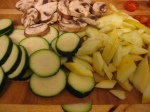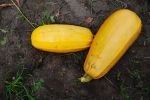 Before making this dish I was unsure what Carbonara actually was. I have had it before but was completely unsure about what was in the recipe. With a little research I found that Carbonara is a pasta dish that focuses on the use of eggs, Parmesan or pecorino romano, black pepper and bacon. Yes that’s right a pasta dish with bacon, this has to be good. In Italy Guanciale is used as this is the traditional unsmoked bacon coming from the cheek or jowl region of the pig. In America pancetta is much easier to find and will be used in finer restaurants but in our case classic bacon will treat us just fine. Carbonara is also known as coal miner’s spaghetti due to its dark appearance after being profusely peppered. It is not known if this was a hearty meal for coal miners or that it was first cooked over charcoal or even had squid’s ink added but all are rumors of its beginnings. The first recorded recipe for Carbonara was in a 1927 Italian cookbook. It is thought to have been invented up when the Americans supplied eggs and bacon during World War II.
Before making this dish I was unsure what Carbonara actually was. I have had it before but was completely unsure about what was in the recipe. With a little research I found that Carbonara is a pasta dish that focuses on the use of eggs, Parmesan or pecorino romano, black pepper and bacon. Yes that’s right a pasta dish with bacon, this has to be good. In Italy Guanciale is used as this is the traditional unsmoked bacon coming from the cheek or jowl region of the pig. In America pancetta is much easier to find and will be used in finer restaurants but in our case classic bacon will treat us just fine. Carbonara is also known as coal miner’s spaghetti due to its dark appearance after being profusely peppered. It is not known if this was a hearty meal for coal miners or that it was first cooked over charcoal or even had squid’s ink added but all are rumors of its beginnings. The first recorded recipe for Carbonara was in a 1927 Italian cookbook. It is thought to have been invented up when the Americans supplied eggs and bacon during World War II.
I saw this particular dish featured on Jamie Oliver’s Jamie at Home, a great show about using fresh ingredients and many things from your own garden, and had to try it. Once you make this dish you will find that making a Carbonara is a technique and you will be able to “Carbonara” just about any kind of pasta dish as long as you stick to the four base ingredients. It’s important when learning to cook that you pick up techniques and not just blindly follow a recipe. When you start to see how ingredients compliment one another you can start to create your own dishes and make whole meals without looking at a recipe. Here is what you’ll need for the Carbonara (if making 3-4 servings);
- 6 Slices of Center cut Bacon
- 2 egg yolks (let them come to room temperature)
- ½ – ¾ cup Parmesan cheese finely grated
- Black Pepper
- 1/8 cup fresh basil and oregano
- 2 cups of your favorite Pasta
- 2 small yellow squash
- 2 small zucchini
- 1 cup mushrooms
Directions:
Start by giving the bacon a rough chop until you get about ½ inch by ½ inch little squares. In a large pan start to brown your bacon until it starts to become crispy, medium to medium high heat. Start to boil your pasta. While pasta and bacon is cooking slice zucchini into quarter inch coins leaving on the skins. Quarter your squash lengthwise and cut out the middle seeds. You then want to cut your squash at an angle making little penne pasta looking shapes. Slice your mushrooms and grate the parmesan.
 When the bacon has started to crisp add your veggies, basil and oregano and turn up the heat to medium high and cook the veggies down. You’re looking to soften them up a bit but leaving a little crunch to them when there done. We don’t want soggy mush so higher heat, stirring frequently, uncovered until they reach your desired liking. While the veggies are cooking down add the Parmesan to 2 egg yolks and gently whisk until thoroughly mixed. If there is too much cheese the sauce will clump up and
When the bacon has started to crisp add your veggies, basil and oregano and turn up the heat to medium high and cook the veggies down. You’re looking to soften them up a bit but leaving a little crunch to them when there done. We don’t want soggy mush so higher heat, stirring frequently, uncovered until they reach your desired liking. While the veggies are cooking down add the Parmesan to 2 egg yolks and gently whisk until thoroughly mixed. If there is too much cheese the sauce will clump up and  be almost impossible to whisk. If this happens add a little heavy cream or water to the mixture until it comes to a mayonnaise consistency. Drain the pasta while reserving about a cup of the pasta water (to be used at the end). Toss all the pasta in with the veggies and remove from heat. Pour the egg/cheese mixture over the pasta and veggies and toss. Add ¼ to ½ cup of the pasta water while stirring or tossing until the sauce becomes silky and coats everything evenly (be careful not to add too much water as you don’t want soupy pasta). Add copious amounts of freshly ground black pepper. You’ve now made your first Carbonara and it couldn’t have been easier or tasted better. This is such a great meal that has the potential to wow your guest or just be a great comfort food dinner. Now that you know how to “Carbonara”, you can substitute any of the veggies for you favorites or add steak, chicken or fish. Enjoy.
be almost impossible to whisk. If this happens add a little heavy cream or water to the mixture until it comes to a mayonnaise consistency. Drain the pasta while reserving about a cup of the pasta water (to be used at the end). Toss all the pasta in with the veggies and remove from heat. Pour the egg/cheese mixture over the pasta and veggies and toss. Add ¼ to ½ cup of the pasta water while stirring or tossing until the sauce becomes silky and coats everything evenly (be careful not to add too much water as you don’t want soupy pasta). Add copious amounts of freshly ground black pepper. You’ve now made your first Carbonara and it couldn’t have been easier or tasted better. This is such a great meal that has the potential to wow your guest or just be a great comfort food dinner. Now that you know how to “Carbonara”, you can substitute any of the veggies for you favorites or add steak, chicken or fish. Enjoy.











